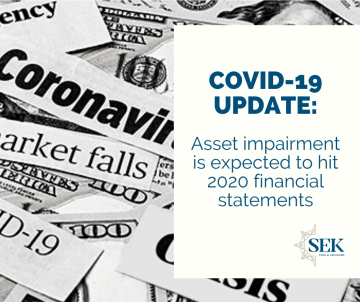Recent News & Blog / Asset impairment is expected to hit 2020 financial statements

June 22, 2020
Some companies are expected to report impairment losses in fiscal year 2020 because of the COVID-19 crisis. Depending on the nature of your operations and assets, the pandemic could be considered a “triggering event” that warrants interim impairment testing.
Examples of assets that may become impaired include long-lived assets (such as equipment and real estate), acquired goodwill and other intangibles (such as customer lists and brands). Here’s what you should know if your organization’s balance sheet includes these types of assets.
What’s a triggering event?
Under U.S. Generally Accepted Accounting Principles (GAAP), goodwill testing must be performed at least annually for public companies that report goodwill on their balance sheet, and for private companies and not-for-profit organizations that don’t elect to amortize goodwill. Goodwill also must be tested for impairment “if an event occurs or circumstances change that would more likely than not reduce the fair value of a reporting unit below its carrying amount.” This situation is referred to as a so-called “triggering event.”
There are no bright-line rules for which events trigger a goodwill impairment test. However, the accounting rules outline the following elements to consider:
- Macroeconomic conditions, such as a deterioration in general economic conditions, limitations on accessing capital and fluctuations in foreign exchange rates,
- Industry and market considerations, such as an increased competitive environment, a change in the market for an entity’s products or services, and a regulatory or political development,
- Cost factors, such as increases in raw materials or labor rates,
- Overall financial performance trends, such as negative or declining cash flows or a decline in revenue compared with prior periods, and
- Other relevant events specific to the entity or reporting unit, such as changes in management, key personnel, strategy or customers; contemplation of bankruptcy; or litigation.
For public companies, a sustained decrease in share price — considered in both absolute terms and relative to peers — may qualify as a triggering event.
Entities that follow GAAP also should consider whether to test their other intangibles and long-lived assets for impairment. Triggering events for these assets are similar to those considered for goodwill. Triggering events must be evaluated within the context of your specific organization.
To test or not to test?
Private entities and nonprofits that have elected the accounting alternative to amortize goodwill don’t get a break from impairment testing when a triggering event occurs. Given the current economic environment, some business and not-for-profit entities are unexpected to conclude that it’s necessary to perform interim impairment tests for goodwill and other assets.
However, impairment testing isn’t a foregone conclusion. During the pandemic, some organizations may experience an increase in demand and profitability for their products and services, despite the overall decline in the macroeconomic conditions of the overall economy. These entities may not be required to perform interim impairment tests.
How to report and measure losses
If an asset is impaired, the amount reported on the balance sheet for that asset is reduced to its fair value. In addition, a loss is reported under other operating income and expenses on the income statement, reducing the organization’s earnings by a proportionate amount.
Quantifying impairment can be complicated in today’s uncertain marketplace. Estimating fair value may require external market analyses and complex discounted cash flow techniques. We can help you get it right. Contact us for more information.
© 2020